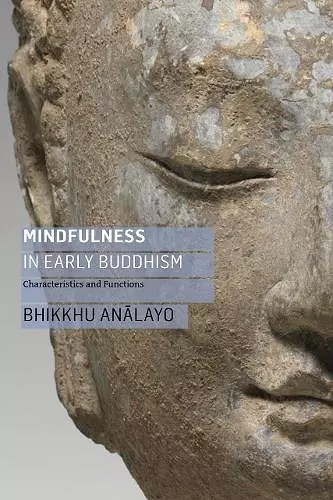Mindfulness in Early Buddhism
Characteristics and Functions
Format:Paperback
Publisher:Windhorse Publications
Published:22nd Sep '20
Should be back in stock very soon

An invaluable resource for Buddhist scholars, meditation teachers, and practitioners wishing to deepen their own practice of mindfulness. In this in-depth guide, the author examines all aspects of mindfulness practice, explores the history of mindfulness in the Buddhist tradition, and provides instructions for meditation practice.
'Bhikkhu Analayo's Mindfulness in Early Buddhism, Characteristics and Functions is a result of his comparative study of mindfulness in Pali and Chinese texts. In my view, this is one book that everybody seriously teaching and practising mindfulness meditation should have in their homes as a reference book on various aspects of mindfulness. It can amazingly benefit Buddhists from different traditions who are unfamiliar with each other's meditation practices. Reading this book opens our minds to see various usages, similarities, dissimilarities, and misinterpretations of mindfulness.' - H. Gunaratana Mahathera, author of Mindfulness in Plain English; 'Mindfulness in Early Buddhism, Characteristics and Functions is a treasure trove of teachings, illuminating in depth and detail the many aspects and nuances of mindfulness. Through his own practice and scholarly research, Bhikkhu Analayo explores the different characteristics and functions of mindfulness and how they lead us on to freedom. A wonderfully deep dive into what liberates the mind.' - Joseph Goldstein, author of Mindfulness: A Practical Guide to Awakening; The definitive resource for scholars, meditation teachers, and those practitioners interested in a high-resolution framing of the meaning and cultivation of mindfulness under a wide variety of life circumstances, as illuminated by a careful and broad-minded exegesis of specific texts (Pali Nikayas and Chinese Agamas) written down closest to the time of the Buddha. Analayo here provides a rich framework for examining, reflecting upon, and deepening one's own ongoing practice and understanding in light of these earliest teachings on the cultivation of mindfulness as the direct path for the liberation and the extinguishing of suffering. He ends by offering his own inclusive definition of mindfulness. Much of what is illuminated here may be highly germane to current neuroscience studies of meditation, including brain networks subtending salience, memory (including working memory), proprioception, executive function, emotion regulation, and sense of self. - Jon Kabat-Zinn, Founder of MBSR, author of The Healing Power of Mindfulness and Mindfulness for All; 'Mindfulness in Early Buddhism, Characteristics and Functions is an invaluable and timely contribution to our understanding of the early Buddhist notion of "mindfulness". Analayo makes available, through scrupulous translation and astute analysis, the vast scriptural and commentarial literature bearing on the topic in Pali, as well as the early Agama literature - often ignored - that survives in Chinese. The volume stands as the most comprehensive sourcebook and exhaustive study of the early materials to date, and should be required reading of anyone interested in the Buddhist roots of mindfulness practice.' - Robert Sharf, author of Coming to Terms with Chinese Buddhism: A Reading of the Treasure Store Treatise; 'Since so few practitioners have the ability to access the early Buddhist discourses, which are preserved in languages as diverse as Pali, Gandhari, Sanskrit, Chinese, and Tibetan, this book, as with the author's other writings, is an important contribution to the topic. Another consequence of letting the primary texts, the discourses attributed to the Buddha, speak for themselves through providing very readable and fluent translations of them, supplemented with the author's commentary and interpretations, is that the book is a delight to read because the early discourses are so varied, fresh, and informative, with teachings liberally illustrated and enhanced through similes, metaphors, and the like.' - Mark Allon, author of Style and Function: A Study of Dominant Stylistic Features of the Prose Portions of Pali Canonical Sutta Texts and Their Mnemonic Function and Three Gandhari Ekottarikagama-Type Sutras: British Library Kharosthi Fragments 12 and 14, from the Foreword
ISBN: 9781911407553
Dimensions: unknown
Weight: unknown
304 pages